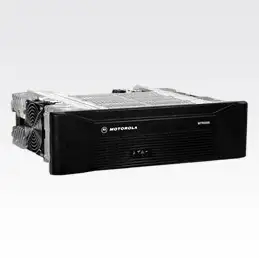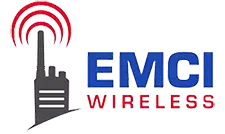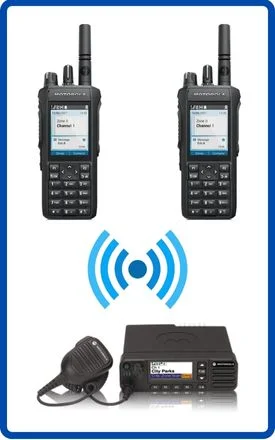
Motorola MTR 2000 VHF, UHF, 800 and 900 MHz Analog Base Repeater
Status: Discontinued
The Motorola MTR 2000 keeps you connected.
Motorola has canceled the MTR2000 repeater. If you are looking for a replacement repeater, please check out our current Motorola repeater models.
Motorola’s MTR 2000 Station/Repeater/Receiver is a continuous-duty analog base/repeater station for use on both conventional and trunking systems in the VHF, UHF, and 800 and 900 MHz bands. Onboard self-testing and a microprocessor-based design keeps system up-time at a maximum.
Feature Highlights
Analog operation
For conventional and trunking (SMARTNET, PassPort) systems.
Programming and diagnostic testing
Runs through a personal computer, shortening maintenance time.
Compact design
Maximum flexibility in a small design optimizes site space.
Software-intensive design
Allows for upgrades and complete system migrations easily.
Network adaptability
Functions on VHF, UHF and 800 and 900 MHz channel spacing.
Field-replaceable units (FRUs)
Keeps the modules functionally separate.
Switching power supply
Functions over a wide range of voltages and frequencies.
Standard Package Includes:
Basic Package Includes:
- MTR2000 stations are cabinet and rack-mountable and ship standard in a
shipping box - MTR2000 utilizes a switching power supply (85-264VAC, 47-63Hz)
- Tone Remote Control Only
- 4 Wire Audio
- 1.5 PPM Frequency Stability (VHF)
- Single Circulator (100 Watts)
- Double Internal Circulator (30 Watts)
- 32 Channel Operation (Tone Remote Control Access Limited to 14 Channels)
- Type N Antenna Connectors for TX/RX
- Continuous Duty Cycle Operation
- Programmable Channel Selection (12.5/20/25 kHz)
- Installation and Operational Manual
- UHF Version Discontinued
Models
Motorola part number: MTR2000 Repeater
Frequency Compatibility
The Motorola MTR2000 repeater is available in VHF band with power output to 100 watts. The MTR2000 analog repeater is the ideal solution for large in-house communication systems and wide area trunking or conventional systems.
Technology Compatibility
Analog
Analog technology is a legacy method of communication that enables the transmission of voice between users over dedicated frequencies. While analog technology has served its purpose effectively for decades, it is rapidly being replaced by digital technology, which offers enhanced clarity, security, and efficiency in communication. Digital technology also provides for the ability to incorporate data protocols, whereas analog operation is typically voice communication only. Nevertheless, analog technology remains a critical part of the legacy infrastructure for many land mobile radio systems, particularly in regions where digital upgrades may still be pending.
Radio System Compatibility
Motorola Two-Way Radio Systems
Direct Mode
All MOTOTRBO two-way radios have the capability to connect directly: radio-to-radio, for basic voice, data, text, and application support. However, this approach has limitations.
Conventional
A conventional system is a step up from basic radio-to-radio communications. Radios communicate via a high-power repeater, giving better coverage and more centralized control.







